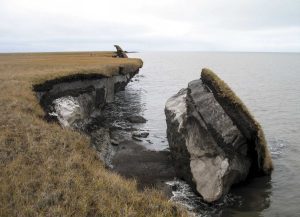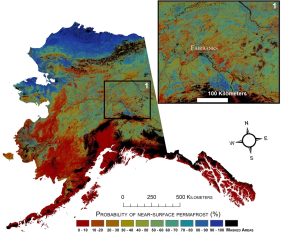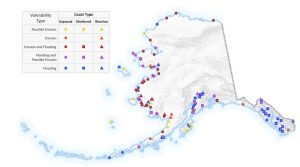Topics - Alaska
Alaska
Changes to the Environment

Alaska is a land of extremes. The state consists of 586,400 square miles of land and includes 32 ecoregions ranging from temperate rainforest to arctic tundra.1 The tundra is a vast, treeless, and windswept landscape with thick permafrost and little annual precipitation. In contrast, the temperate rainforest is rich in vegetation, and rivers and steep valleys remain from ancient glaciers. In some places temperatures can range anywhere from above 90°F in the summer to nearly -80°F in the winter. Drastic differences such as this has provided a unique landscape that the indigenous peoples of the area have adapted to for centuries.
Climate change has had a large impact on Alaska’s ecosystems, resulting in migratory changes in species, melting permafrost, shrinking and disappearing sea ice, earlier thaws and later freezes. Collectively these changes, some of which are already being seen, will have a deep impact on the people of the North, endangering their way of life and existence.
Most villages in Alaska rely heavily on marine and freshwater species for their subsistence lifestyle. Salmon, whales, walruses, and seals all contribute to the rural Alaskan diet. Naturally, many Alaskan villages are situated close to surface-water sources, including rivers, streams, and lakes, as well as Alaska’s approximately 44,000 miles of coastline. The thin edge separating land from sea houses a majority of the state’s population. As average global temperatures continue to increase, some of these coastal Alaskan areas are experiencing increased erosion and flooding.

Erosion, flooding, and permafrost melt are natural weather and geological events that, particularly in Alaska, are becoming more severe because of climate change. Floods in Alaska can be a result of coastal storm surge, ice jams in rivers, high precipitation events, or rapid thawing of winter snow and ice.1 Climate change alters precipitation patterns and can worsen storms, increasing the risk of dangerous flooding events. Flooding can accelerate erosion by carrying away sediment and potentially disrupting vegetation that is actively preventing erosion in a particular area. Permafrost melt can also accelerate erosion, as frozen soil will warm and destabilize, which can lead to smaller sediment being carried away, or large floes of land breaking off on a much larger scale.2 Along with accelerating other natural hazards, permafrost melt can damage infrastructure and kill vegetation. As the ground thaws, it becomes marshy and floods. The land can no longer support the weight of buildings, infrastructure, and vegetation.
As environmental threats to Native Villages increase in severity, many of them are having to determine climate adaptation plans and methods that best accommodate their communities. Villages are choosing between three climate adaptation methods, Relocation, Managed Retreat, and Protect in Place.
According to the United States Government Accountability Office (GAO), more than 200 Alaska Native Villages suffer from erosion and/or flooding. Although these villages have long suffered from such naturally occurring adversities, rising temperatures are in part to blame for the increasing severity.3 31 of these villages are in “imminent danger” and may have to be relocated. Some are already in the process of relocation.

The major obstacle in relocating a village in remote parts of Alaska is the lack of financial resources. In villages that cannot even afford adequate waste-disposal systems, the idea of funding a complete relocation may seem unrealistic. Estimates of relocation costs are dependent on a variety of factors, some being the size of the village, and the new location. Most relocation cost estimates are in the tens to hundreds of millions of dollars.2
The federal government has increased its awareness of this issue, and although programs are available (through the Federal Emergency Management Agency, Housing and Urban Development, and the Department of Transportation) for disaster relief, the total funding needed for an undertaking of this type and size is not available by any conventional means.
To attempt the mitigation of the cost of relocation, Villages may opt for a Managed Retreat approach to changing landscapes and climate. This adaptation strategy focuses on the most vulnerable community members and structures and relocates those to higher and more stable ground within the existing Village. For example, homes on the coast may be moved further inland, whereas homes far from the shore will remain put. Managed Retreat may be paired with Protect in Place measures to ensure greater resilience to the Village at large.
Some villages are taking preventative measures against flooding and erosion with the construction of seawalls and barriers. This climate adaptation method most closely aligns with Protecting in Place, where communities choose to remain at their original site and construct means of resiliency against the challenges associated with a changing climate. Seawalls can prevent coastal erosion by reinforcing the coastline and providing a barrier against strong storm surges and waves. Additionally, Native Villages are conducting studies pertaining to the flooding of specific infrastructure (i.e., runways and evacuation roads in Point Hope) and methods for mitigating those impacts. However, these measures are costly and are not permanent solutions.
Sources:
- Alaska Department of Fish and Game. (2004). Alaska’s 32 Ecoregions. Alaska Department of Fish and Game. Available online from: https://www.adfg.alaska.gov/index.cfm?adfg=ecosystems.ecoregions#prettyPhoto/0/ [accessed March 20, 2023].
- Alaska Department of Natural Resources. (2022). Flooding & Landslides. Alaska Department of Natural Resources. Available online from: https://dggs.alaska.gov/popular-geology/flooding-landslides.html [accessed January 25, 2023].
- Lara, M. (April 2022). Driven by climate change, thawing permafrost is radically changing the Arctic landscape. PBS News Hour. Available online from: https://www.pbs.org/newshour/science/driven-by-climate-change-thawing-permafrost-is-radically-changing-the-arctic-landscape [accessed January 25, 2023].
- Kitka, Julie. (December 2018). Erosion and Alaska Native Communities. Alaska Federation of Natives. Available online from: https://www.nativefederation.org/wp-content/uploads/2018/12/AFN-AKDayErosion-December2018-ONLINE.pdf [accessed January 24, 2023]
CONNECT WITH US
Nikki Cooley
Co-Director
Nikki.Cooley@nau.edu
Karen Cozzetto
Manager
Karen.Cozzetto@nau.edu
Your tax deductible donation supports ITEP’s programming efforts.
Please contact us if you would like to contribute to our endowment or for any additional information regarding donations.

